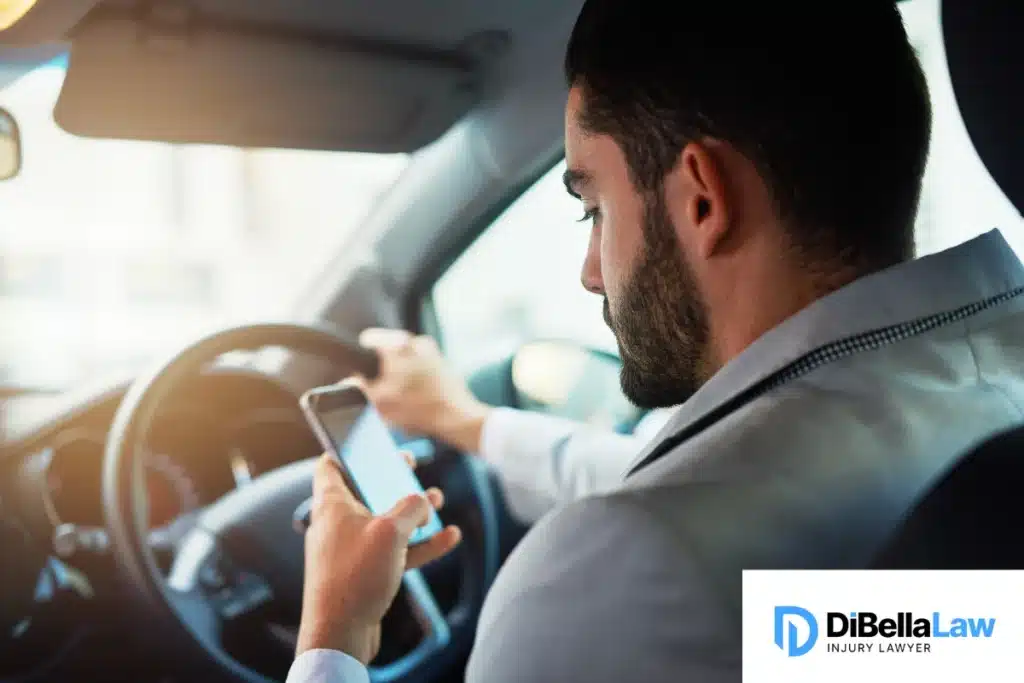Distracted driving is one of the leading causes of traffic collisions nationwide. According to the Centers of Disease Control and Prevention (CDC), approximately nine people are killed and more than 1,000 injured on a daily basis in crashes that are reported to involve a distracted driver.
While distracted driving is one of the most common acts of negligence that leads to traffic accidents, it is also one of the more difficult acts to prove in a court of law. Evidence must be provided that the driver wasn’t paying attention to the road, and that his or her behavior led directly to the accident taking place.
Beyond texting while driving, distracted driving can include things like adjusting the radio, applying makeup, eating and drinking, or navigating with pets in your lap. So, how can you get evidence that shows the other driver was distracted at the time of your accident?
We here at DiBella Law Injury and Accident Lawyers, have handled countless distracted driving cases, and here are methods we have found are most useful in proving the driver who hit you was distracted.
Places to Gather Evidence of Distracted Driving
- Law Enforcement Testimony and/or Police Report– Police reports that are filed following a traffic collision can include an initial assessment of fault based on the evidence gathered by the police officer present. Suppose you witnessed the other party driving in a distracted manner before the incident. In that case, you should let the officer know so that this information can be included in the official crash report. If the officer witnessed the accident, and saw that the other driver was distracted, it is useful to have him testify to that fact.
- Witnesses– Witnesses include anyone who saw the accident. This can be bystanders who were watching the street, or passengers in nearby vehicles at the time of the crash. When police are called to the scene afterward, they can take witness statements on what occurred. If your case happens to go to trial, you can bring in the witnesses to testify about any distracted-driving behaviors that they may have seen take place.
- Cell Phone Records– Records of calls and text messages can be used in court to prove that the negligent driver was using a cell phone when the crash occurred. It’s already illegal in most states to use a phone while behind the wheel of a motor vehicle, so having the phone records can serve as strong evidence of negligence.
- Photographic or Video Evidence– Footage from surveillance cameras, driver or police dash cams, and cell phone videos shot by passengers in other vehicles can catch distracted drivers dead to rights. If introduced in court, this can provide irrefutable evidence of how the individual in question was driving in a distracted manner.
- The Other Driver Admits Guilt– Some drivers may own up to their negligent behavior after a collision. However, even if the other driver says, “Sorry, I was answering the phone and didn’t notice the stop sign,” your case still might not be as open and shut as it seems. Even if the other driver admits fault, the admission of guilt may not be admissible in court under the hearsay doctrine. Though the admission may not be allowed in court, it may be used to support your case in general, especially if you’re pursuing a settlement out-of-court.
Hit by a Distracted Driver? Call DiBella!
If you or a loved one has been involved in a traffic collision, and you suspect the other party was driving distracted, you deserve an attorney who will fight to get you justice. The legal team at DiBella Law Injury and Accident Lawyers, is dedicated to getting clients the compensation they deserve after someone else throws their life in disarray.
Call our Boston office at (617) 663-0665for a no-obligation consultation. Let our Boston car accident lawyers handle your case while you and your family focus on healing and moving on.
